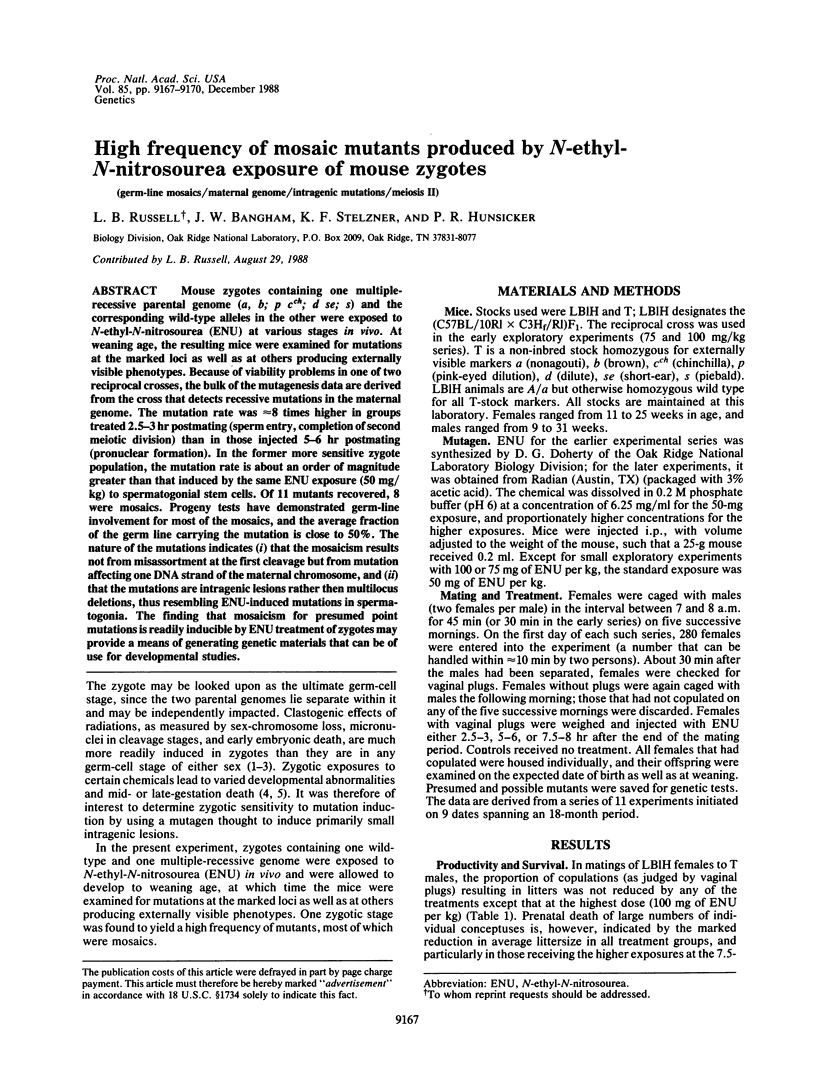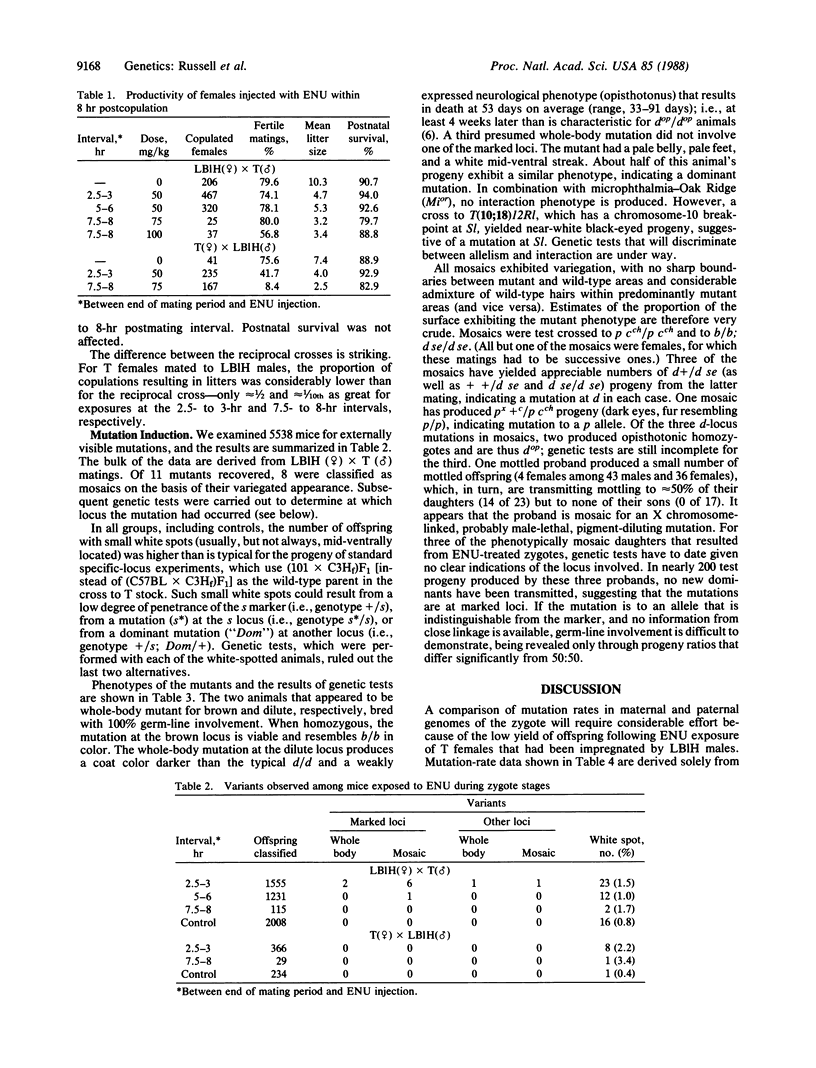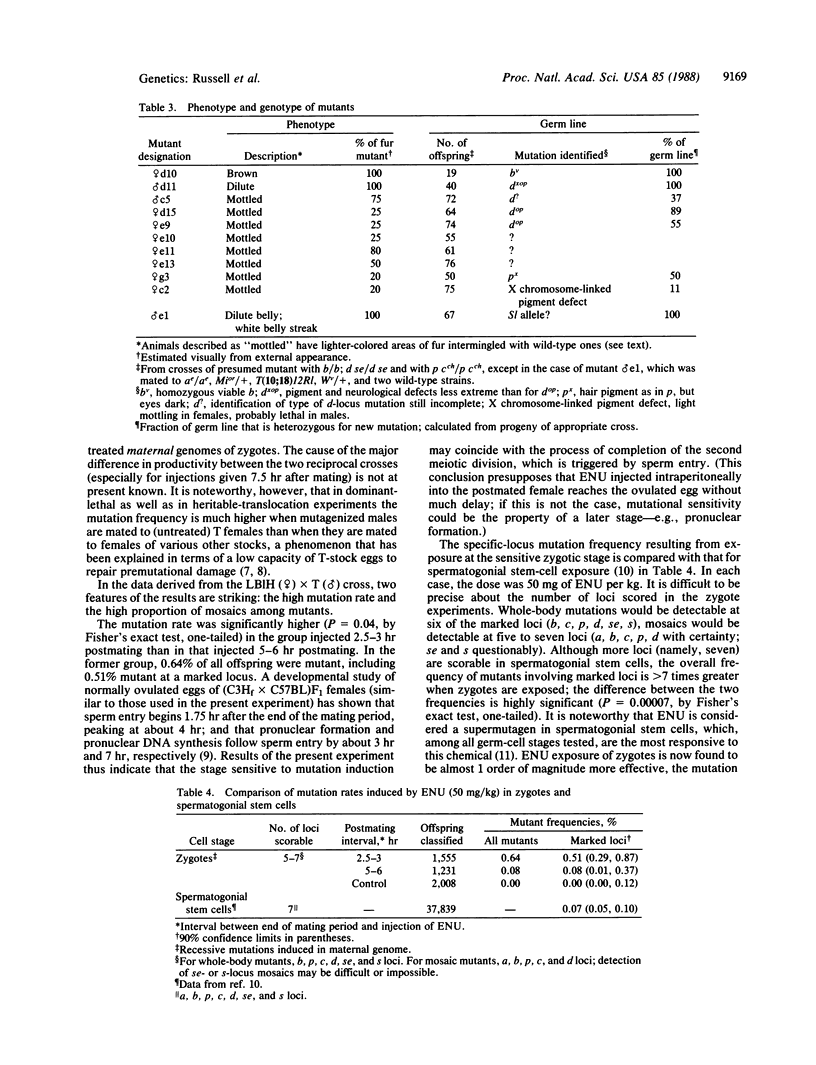Abstract
Mouse zygotes containing one multiple-recessive parental genome (a, b; p cch; d se; s) and the corresponding wild-type alleles in the other were exposed to N-ethyl-N-nitrosourea (ENU) at various stages in vivo. At weaning age, the resulting mice were examined for mutations at the marked loci as well as at others producing externally visible phenotypes. Because of viability problems in one of two reciprocal crosses, the bulk of the mutagenesis data are derived from the cross that detects recessive mutations in the maternal genome. The mutation rate was approximately 8 times higher in groups treated 2.5-3 hr postmating (sperm entry, completion of second meiotic division) than in those injected 5-6 hr postmating (pronuclear formation). In the former more sensitive zygote population, the mutation rate is about an order of magnitude greater than that induced by the same ENU exposure (50 mg/kg) to spermatogonial stem cells. Of 11 mutants recovered, 8 were mosaics. Progeny tests have demonstrated germ-line involvement for most of the mosaics, and the average fraction of the germ line carrying the mutation is close to 50%. The nature of the mutations indicates (i) that the mosaicism results not from misassortment at the first cleavage but from mutation affecting one DNA strand of the maternal chromosome, and (ii) that the mutations are intragenic lesions rather than multilocus deletions, thus resembling ENU-induced mutations in spermatogonia. The finding that mosaicism for presumed point mutations is readily inducible by ENU treatment of zygotes may provide a means of generating genetic materials that can be of use for developmental studies.
Full text
PDF



Selected References
These references are in PubMed. This may not be the complete list of references from this article.
- Generoso W. M., Cain K. T., Krishna M., Cunningham E. B., Hellwig C. S. Evidence that chromosome rearrangements occur after fertilization following postmeiotic treatment of male-mice germ cells with EMS. Mutat Res. 1981 Mar;91(2):137–140. doi: 10.1016/0165-7992(81)90087-7. [DOI] [PubMed] [Google Scholar]
- Generoso W. M., Cain K. T., Krishna M., Huff S. W. Genetic lesions induced by chemicals in spermatozoa and spermatids of mice are repaired in the egg. Proc Natl Acad Sci U S A. 1979 Jan;76(1):435–437. doi: 10.1073/pnas.76.1.435. [DOI] [PMC free article] [PubMed] [Google Scholar]
- Generoso W. M., Rutledge J. C., Cain K. T., Hughes L. A., Braden P. W. Exposure of female mice to ethylene oxide within hours after mating leads to fetal malformation and death. Mutat Res. 1987 Feb;176(2):269–274. doi: 10.1016/0027-5107(87)90058-3. [DOI] [PubMed] [Google Scholar]
- Generoso W. M., Rutledge J. C., Cain K. T., Hughes L. A., Downing D. J. Mutagen-induced fetal anomalies and death following treatment of females within hours after mating. Mutat Res. 1988 May;199(1):175–181. doi: 10.1016/0027-5107(88)90243-6. [DOI] [PubMed] [Google Scholar]
- Hitotsumachi S., Carpenter D. A., Russell W. L. Dose-repetition increases the mutagenic effectiveness of N-ethyl-N-nitrosourea in mouse spermatogonia. Proc Natl Acad Sci U S A. 1985 Oct;82(19):6619–6621. doi: 10.1073/pnas.82.19.6619. [DOI] [PMC free article] [PubMed] [Google Scholar]
- Krishna M., Generoso W. M. Timing of sperm penetration, pronuclear formation, pronuclear DNA synthesis, and first cleavage in naturally ovulated mouse eggs. J Exp Zool. 1977 Nov;202(2):245–252. doi: 10.1002/jez.1402020214. [DOI] [PubMed] [Google Scholar]
- Lewis S. E., Johnson F. M., Skow L. C., Popp D., Barnett L. B., Popp R. A. A mutation in the beta-globin gene detected in the progeny of a female mouse treated with ethylnitrosourea. Proc Natl Acad Sci U S A. 1985 Sep;82(17):5829–5831. doi: 10.1073/pnas.82.17.5829. [DOI] [PMC free article] [PubMed] [Google Scholar]
- Russell L. B. Analysis of the albino-locus region of the mouse. II. Mosaic mutants. Genetics. 1979 Jan;91(1):141–147. doi: 10.1093/genetics/91.1.141. [DOI] [PMC free article] [PubMed] [Google Scholar]
- Russell L. B. Definition of functional units in a small chromosomal segment of the mouse and its use in interpreting the nature of radiation-induced mutations. Mutat Res. 1971 Jan;11(1):107–123. doi: 10.1016/0027-5107(71)90036-4. [DOI] [PubMed] [Google Scholar]
- Russell L. B., Montgomery C. S. Radiation-sensitivity differences within cell-division cycles during mouse cleavage. Int J Radiat Biol Relat Stud Phys Chem Med. 1966;10(2):151–164. doi: 10.1080/09553006614550201. [DOI] [PubMed] [Google Scholar]
- Yarosh D. B. The role of O6-methylguanine-DNA methyltransferase in cell survival, mutagenesis and carcinogenesis. Mutat Res. 1985 Jan-Mar;145(1-2):1–16. doi: 10.1016/0167-8817(85)90034-3. [DOI] [PubMed] [Google Scholar]


